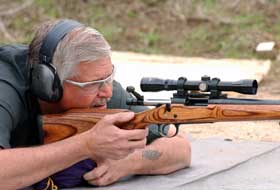I said yesterday that Bill Laughridge at Cylinder & Slide had suggested that he take my two competition New Blackhawk .357s to "100%." I got an email last night that asked, quite reasonably, what's the difference between a 90% gun and a 100% gun?
We all have different definitions...here's mine:
The devil is in the details, as usual. Most guns that you get out-of-the-box are, essentially, 80% guns. They are usually 100% reliable, although they may be sensitive to ammunition or designed around specific bullet configurations; trigger pulls are set by company liability lawyers, serviceable but probably heavy for an experienced shooter's taste. Most modern guns will shoot 5-inches at 25 yards or thereabout, which is fine for any Real World useage.
That's why all the gun rags do those silly tests, where they discover that the newest bestest MAXIMUS GLADIOUS BLASTER "prefers" WW ball and will consistently shoot 4.756 inches at 25 yards from a rested position. I don't mean to sound snooty here, but for most of the shooters out there, that's just fine. A few years back one of the major gun manufacturers set out on a quest to see how much they're guns were shot in their "working lives." The average was — brace yourself — less than 100 rounds a year. Believe me, if you're shooting 100 rounds a year, you profoundly NO NOT need a lighter trigger, unless you're excited about shooting yourself in the foot.
The reason the gun companies deliver 80% guns is not because they cynically think you're not going to shoot it; it's because of Criteria #1...100% reliability. You may be betting your life on these things, and the gun companies are aware that the guns must go "BANG!" when you pull the trigger. Since all guns are ultimately compromises, balances between differing sets of tolerances, the "default compromise" is reliability at the expense of other operating issues, because addressing those other operating issues while maintaining 100% reliability starts jacking the gun's cost through the ceiling (which is why you get what you pay for, suckah!!!).
When we take the gun to 90%, we essentially adjust the trigger pull and a few of other other operating controls while maintaining 100% reliability. We might change the grips, or, on a 1911 platform, change the mainspring housing and replace the sights with something more to our liking — although most modern handguns have sights that are just fine as-is. But still, Dick Heinie and Wayne Novak gotta eat, just like buzzards (homage to Clint Eastwood!)!!! A 90% 1911 might have a tiny bit of accuracy work done, usually revolving around the link/barrel lock-up, but if we go further, we're heading into the real slick-up region.
Here's Bill's invoice for taking my competition Blackhawks to 100%:
• Recut and polish barrel throatEssentially, the gun has been blueprinted, with all parts now working to spec. Friction has been reduced wherever possible. Known weaknesses within Ruger single actions (the basepin, for instance, or the need to polish the transfer bar) have been remedied. The triggers are crisp and break clean at a little over 2.5 pounds on both guns. Springs are all beefed up to take the demands of competition. 25 yard test groups are in the 1-1.75 inch range with test ammo. In short, the guns will do their part if I do mine...which, I admit, is highly unlikely!!!
• Recrown barrel 11 degrees
• Light chamfer on cylinder mouths
• Install Power Free Spin Pawl
• Install oversize basepin
• Competition trigger job 2.5-3 pounds
• Install Wolffe XP basepin latch spring
• Check and adjust timing
• Parts polishing as needed
• Check and adjust timing if necessary
• Refinish as necessary
• Test fire
You can get a trigger job on a single action for between $75-150 all day, every day (including new springs). A 1911 trigger job runs from $100-200 or more from a "name" maker, including replacing most of the parts. The most common 1911 trigger job these days includes replacing hammer/trigger/sear/springs with a pre-fitted kit from Cylinder & Slide.
If you want to get to 100%, it's like watching a New York City taxi meter run up. Figure a minimum of $500 for a single action revolver, a little more for a DA revolver and at least $1000 for a 1911 (replace barrel, fire control group, springs, fit).
Can you get cheaper????
You betcha!
Heck, I can swap out parts and do some grinding on a Ruger SA, an S&W revolver or a 1911, easy. You'll notice, however, that I send MY guns out!
Wonder why that is?

2 comments:
Hell of a lot of trouble for a SPAMMER to go to!!!!
Well, at least he's courteous. Never seen that before.
Post a Comment